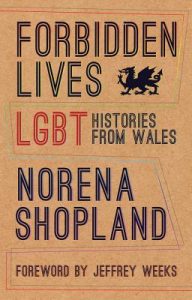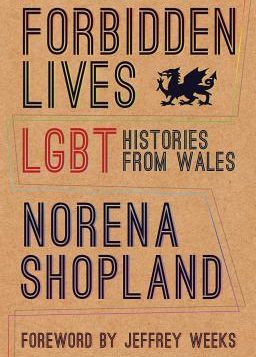 Forbidden Lives: LGBT Histories from Wales
Forbidden Lives: LGBT Histories from Wales
by Norena Shopland
Seren Books. 248 pages, $17.
WALES HAS ALWAYS BEEN a nation fiercely protective of its national identity. Much of that energy has focused on preserving the country’s unique and exotic language (think of all those gargantuan, consonant-heavy Welsh place names). Welsh nationalists’ resistance to the British has been strident and even violent. In 1936, three nationalists set fire to a newly built Royal Air Force base in the Welsh heartland. The men became folk heroes, dubbed “The Three,” and photographed for a postcard that circulated widely for many years after.
In Forbidden Lives, Norena Shopland cites this spirit of rebellion as an animating force in the lives of the many Welsh LGBT pioneers whose stories she has collected in her book. These 25 tales cover a broad swath of Welsh history. They include infamous eccentrics, well-known cultural figures, military personnel, political leaders, and even a few early examples of what we would today call intersex individuals. Although most chapters are biographical accounts of particular people, later chapters are mini-histories of political, legislative, and cultural events. Taken as a whole, Forbidden Lives is a combination of biography and cultural history.
The book abounds with curiosities and surprises. There’s Peggy Evans (b. 1696), who was large and masculine, sported facial hair, smoked a pipe, and was famous for winning contests of physical strength against any man who challenged her. There’s Katherine Philips (b. 1632), the “Welsh Sappho,” who published some of the earliest same-sex poetry in the British Isles. What’s surprising, based on Shopland’s version of their lives, is how openly these people transgressed the bounds of “heteronormativity.” (This example notwithstanding, Shopland mostly avoids the abstruse academic jargon so prevalent in queer studies).
If there’s a hall of fame of Welsh queers, then the “Ladies of Llangollen” are its stars. They were Lady Eleanor Butler (b. 1739) and Sarah Ponsonby (b. 1755), who shared a Welsh cottage for fifty years, living as if married. They became international celebrities after Anna Seward, a leading poet, published a ballad about them that became wildly popular. For years, their small home was visited by luminaries such as William Wordsworth, Sir Walter Scott, Prime Minister Gladstone, and the Duke of Wellington. Shopland’s profile includes a famous 19th-century portrait of the Ladies.
Although most of Shopland’s stories are about women and the transgendered, she profiles some men. Among them is Hugh Despenser who, along with Piers Gaveston, took part in the sordid events that led to the downfall and death of King Edward II. Shopland has researched the racy tale well, and she dispels certain myths in the well-known story, including that detail about the red-hot poker. In all of her accounts of pre-20th-century events, Shopland reminds us that the historical record can be murky, and that LGBT concepts such as “gay” and “transgender” simply can’t be retroactively applied to such long-ago lives.
Among her latter-day subjects is travel writer Jan Morris, one of the most famous and eloquent of contemporary transsexuals. As an active Welsh nationalist who has written histories of Wales and chronicled her life in the Welsh countryside (A Writer’s House in Wales in 2002), Morris is a worthy addition to Shopland’s roster of gender pioneers. The profile of Morris includes ample quotations from her wonderful memoirs, Conundrum (1974) and The Pleasures of a Tangled Life (1989).
The second half of the book is focused on historical essays about significant queer-related events in Wales and Great Britain. She devotes a chapter to the infighting within psychoanalytical circles over how to classify and treat LGBT patients. Two chapters cover the legal and legislative efforts around the struggle for LGBT rights within the U.K., particularly the famous Wolfenden Commission of 1957 and subsequent efforts to reform the laws related to LGBT rights. Also included are chapters recounting the AIDS crisis in Wales, as well as a brief history of the Welsh Gay Pride movement. Forbidden Lives offers an expansive overview of Welsh LGBT history, and the book provides a good reading list for those interested in exploring that history more closely.
________________________________________________________






